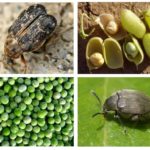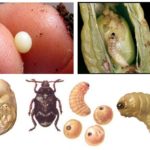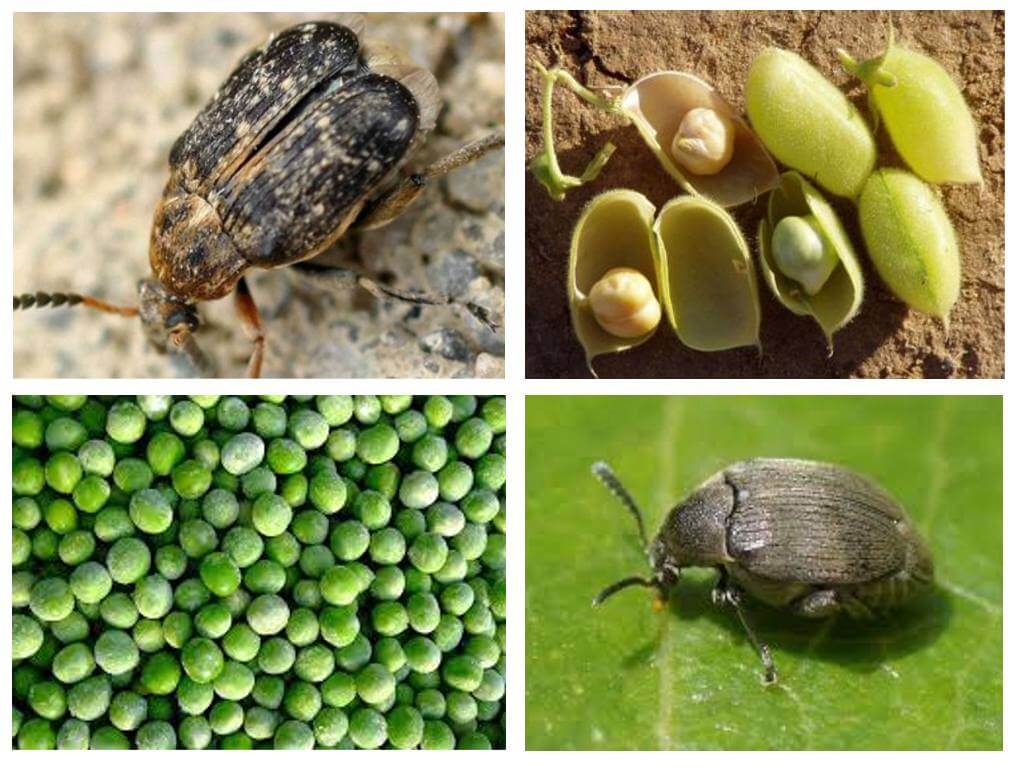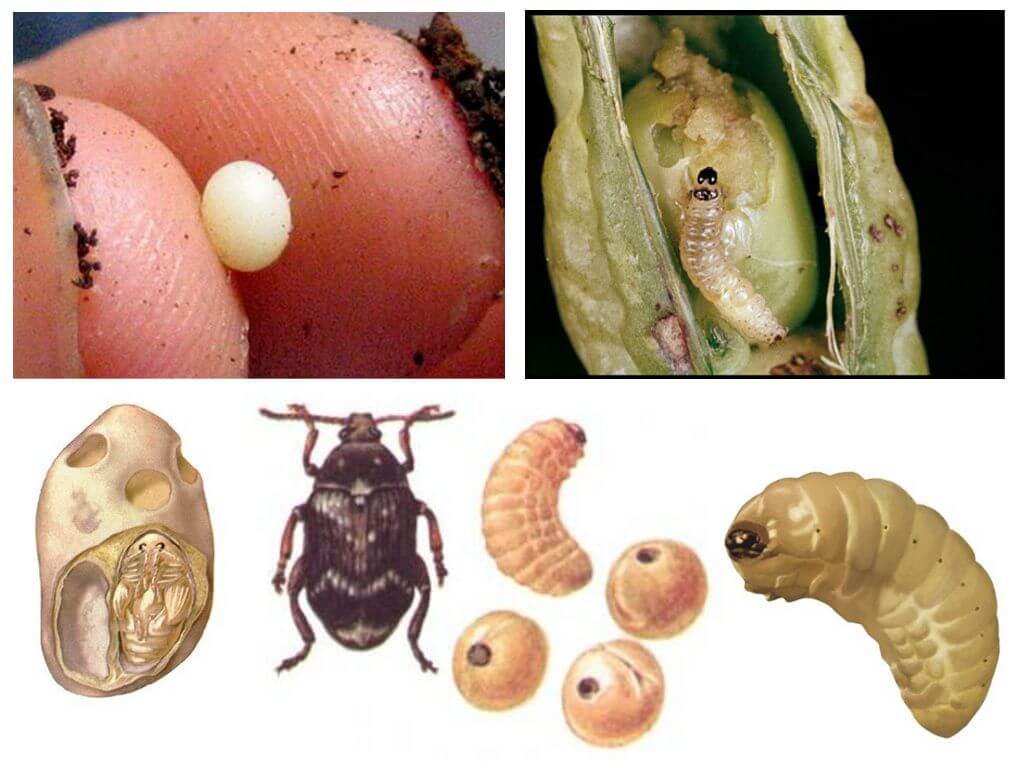Pea weevil
Content
- Pea weevil
- Eggs and larvae of pea weevil
A malicious pest of cultivated varieties of peas is a small beetle of the Bruchus genus, known as the pea weevil. For the first time in Russia it was discovered in 1857. A pest from the Mediterranean has spread, thanks to the infected seeds of legumes. However, it should be noted that the insect feeds exclusively on peas.
Features of the structure and appearance of the pea weevil
A small black bug with an elongated head,belonging to the family of beetles of the order Coleoptera, reaches a length of 4-5 millimeters. His body has a wide oval specific shape. From above, the insect is covered with a reddish-gray thick omission. Small, shortened elytra with oblique light stripe do not cover the entire abdomen, at the end of which there is a white cruciform pattern. Pea grains differ from their counterparts by the presence of this mark. The tibiae, paws of the middle legs, and three segments of the antennae are colored in a reddish-red shade. The pest has bulging eyes, and large pointed teeth are well discernible on the hips of the hind legs.
Non-specialists find it difficult to determine the gender of the pea pests. Insects differ in the structure of the genital organs and the length of the antennae, which are slightly longer in males. Pea seed on the photo presented on our website will allow you to carefully review and familiarize yourself with the features of the insect.
Insect development
The beetle destroying peas is widespread in the European and Asian parts of the Russian Federation, where culture is massively sown. The boundaries of the insect are variable, they vary depending on favorable weather conditions.There are many places where pea grains overwinter. Basically it is the storage in which peas are saved. In the southern regions, a significant part of the kernels waits for the cold season and arranges for wintering in straw hacks, under the bark of trees, among plant remains or in the soil.
Mass beetles emerge from peas at a temperature of 26-28 ° C. At lower temperatures, this process slows down. Increased humidity favorably affects the appearance of pests from infected grains. The overwhelming parasites appear mostly in May, and blooming gardens, clusters of weeds and thickets of bird cherry trees are found along the edges of the forest belts. Pea seeds fall on the fields along with the seeds, but most of them come from nearby places. The largest number of beetles appears on the fields in May, during the mass flowering of plants. The seedlings feed on this period with flower petals and pollen.
Important! Fields of parasites begin to inhabit the edges, gradually occupying the entire plantation. In the mornings and in the evening adult individuals hide in the flowers of peas or between closed young leaves.
Females of the pea weevil begin laying eggs in large quantities in early June.They place a clutch, consisting on average of 35 eggs, on top of the green beans of peas, firmly sticking it on the shoots of plants with a special liquid mass. After drying, it forms a protective sheath, under which half-millimeter amber-yellow oblong eggs are placed. Their development lasts depending on the conditions for 6-12 days. The female can lay from 70 to 200 eggs for the entire period of her life, which lasts one year.
Having emerged into the world, the larva of the weevil gnaws at the fleshy shell of the bean and falls into its middle. Here she gets to the still green grain of peas, in which the whole process of pest development from the larva, pupa and adult beetle takes place.
Interesting! Several individuals can penetrate a pea, but only one survives and develops.
The inlet in the shell of the grain grows over time and a small black dot remains. Before molting, the larvae have a worm-like body of a reddish color, covered with long hairs. The newborn has a pair of legs. After a few days, she molts and becomes legless, with her head strongly drawn into the front of the chest. Its color becomes cream.Feeding on nutritious food, it gradually reaches a length of 5-6 mm. After turning over several times, the larva completes its development. Before pupation, it forms a course up to the very peel skin, but does not gnaw through it. In the cavity formed there will be a young bug. It is enough for him under favorable conditions to press on the lid to go outside. The exit of adult individuals of a grain occurs in the end of July.
Harm caused and control of pea weevil
The parasite is common in all countries of Asia, Europe and North America, where peas are intensively grown. The closest relatives of the pest is the Egyptian pea weevil, bean weevil and other pests of legumes. They all cause tremendous damage to crops. Adult pea seedlings affect the harvested crop in storage, and their larvae in the fields.
Important! Spoiled seeds lose almost 40% of their weight. Their germination decreases to 75% and quality.
It should be avoided to eat and feed livestock infected peat grains. It is dangerous in that beetles, larvae or their excrement, which cause inflammation of the intestine and kidneys, can be found in damaged grains.
In order to preserve the grain fund from parasites, it is necessary to apply all known measures to combat the pea weevil:
- Grain treatment with insecticides;
- Cooling of the grain;
- Preventive processing and maintenance of cleanliness in warehouses.









